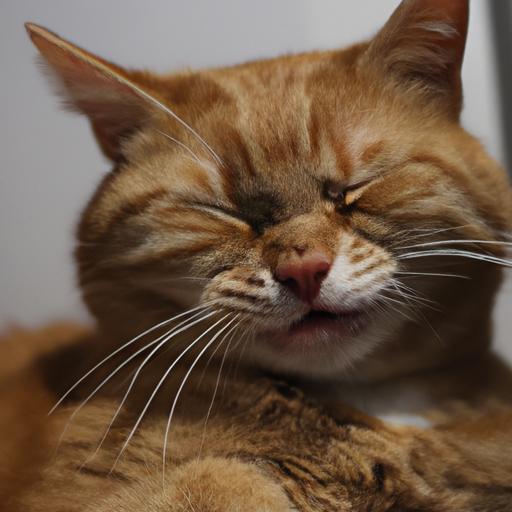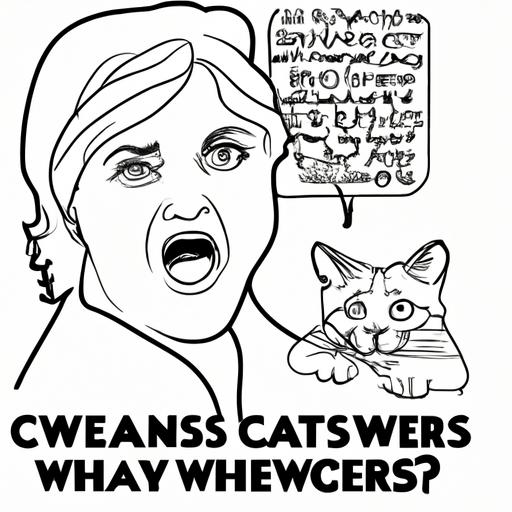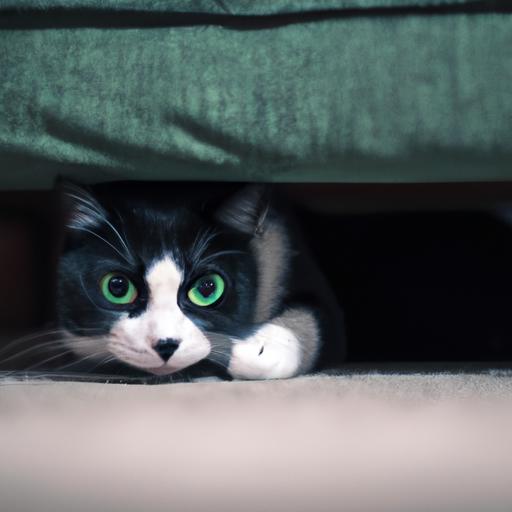Why Does My Cat Meow Too Much? Understanding the Reason Behind Excessive Cat Meowing
We all love our feline friends, but what happens when they won’t stop meowing? It can be frustrating and concerning when your cat seems to be meowing non-stop. Understanding why your cat meows excessively is crucial for their well-being and your peace of mind. In this article, we’ll explore the importance of understanding excessive cat meowing and delve into the common reasons behind this behavior. So, let’s get started!
A. Importance of understanding excessive cat meowing
As responsible cat owners, it’s essential to decode the messages our furry companions are trying to convey through their meows. While cats naturally communicate through various vocalizations, excessive meowing could be indicative of underlying issues. By understanding the reasons behind their excessive meowing, we can address their needs effectively and ensure their overall happiness.
B. Common reasons behind cats meowing excessively
Cats are known for being vocal creatures, but excessive meowing goes beyond their usual communication. Several factors can contribute to this behavior, and it’s crucial to identify the underlying cause. Some common reasons for excessive cat meowing include:
-
Health-related issues: Cats may meow excessively due to medical conditions such as hyperthyroidism, dental problems, or pain. It’s important to rule out any potential health concerns that may be causing discomfort or distress.
-
Environmental factors: Cats thrive on mental stimulation, and a lack thereof can lead to increased vocalization. Boredom, changes in the cat’s environment, or even a need for attention can contribute to excessive meowing.
-
Emotional and behavioral issues: Cats can experience anxiety, stress, or separation anxiety, leading to excessive meowing. Additionally, attention-seeking behavior may result in frequent vocalization.
Understanding these common reasons will help us take the necessary steps to address excessive meowing and restore harmony in our homes.
Stay tuned for the next section, where we’ll delve deeper into understanding cat communication through meowing and the different types of meows and their meanings. By deciphering their language, we can better connect with our furry companions and ensure their well-being.
Understanding Cat Communication through Meowing
Cats have a unique way of communicating with us through their meows. It’s important to understand their natural instincts and the various types of meows they use to express their needs and emotions. By deciphering their meowing language, we can better understand what our feline friends are trying to tell us. Let’s explore this fascinating aspect of cat communication together.
A. Natural instincts of cats to communicate through meowing
From the moment they are born, kittens use meowing as a way to communicate with their mother. As they grow, cats continue to rely on meowing to convey their messages to humans. It’s their way of getting our attention and expressing their desires or concerns. Whether it’s a gentle chirp or a loud yowl, each meow carries meaning behind it.
B. Different types of meows and their meanings
Just like humans have different tones of voice to convey various emotions, cats have a repertoire of meows with distinct meanings. Here are some common types of meows and their possible interpretations:
-
Purring: A soothing and comforting sound, purring often indicates contentment and relaxation in cats. It can also be a sign of seeking attention or expressing happiness.
-
Short and sharp meows: These quick bursts of meowing are often a way for cats to greet their owners or ask for something specific, like food or playtime.
-
Drawn-out meows: Longer meows with a plaintive tone may indicate that your cat is feeling lonely, anxious, or in need of attention. It’s their way of expressing their emotions and seeking companionship.
C. How cats use meowing to express their needs and emotions
Cats are masters at using their vocalizations to express a range of needs and emotions. They may meow when they are hungry, seeking affection, in pain, or wanting to go outside. By paying attention to the context, body language, and frequency of meowing, you can better understand what your cat is trying to convey.
Remember, each cat is unique, and their meowing patterns may vary. It’s important to observe and listen to your cat’s meows to develop a better understanding of their individual communication style.
In the next section, we will explore how to identify excessive cat meowing and determine whether your cat’s vocalization is within normal limits or requires further attention. Stay tuned!
Identifying Excessive Cat Meowing
Excessive cat meowing can be a cause for concern, but how do we differentiate between normal feline communication and excessive meowing? In this section, we will explore the key factors to help you identify if your cat is meowing too much and distinguish between normal and excessive meowing patterns.
A. Defining excessive meowing based on frequency and duration
Determining what constitutes excessive meowing relies on the frequency and duration of your cat’s vocalizations. While it’s normal for cats to meow occasionally to communicate their needs, excessive meowing refers to a persistent and heightened level of vocalization that goes beyond their typical behavior. If you notice your cat meowing significantly more often or for prolonged periods, it could be a sign of excessive meowing.
B. Factors to consider when evaluating if a cat meows too much
When evaluating if your cat meows excessively, it’s important to consider various factors that may contribute to their vocalization. These factors include:
-
Context: Assess the situations in which your cat meows. Are they meowing excessively during specific activities, such as mealtime or playtime? Understanding the context of their vocalizations can provide insights into their needs.
-
Consistency: Evaluate if the excessive meowing is a consistent behavior or if it occurs intermittently. Consistency can help identify patterns and potential triggers for their excessive vocalization.
-
Impact on daily life: Consider how the excessive meowing affects your cat’s overall well-being and daily routine. If their meowing disrupts their eating, sleeping, or socialization patterns, it may be considered excessive.
C. Differentiating between normal and excessive meowing patterns
Distinguishing between normal and excessive meowing patterns requires careful observation and understanding of your cat’s typical behavior. Some key points to consider when making this distinction include:
-
Baseline behavior: Familiarize yourself with your cat’s usual vocalization patterns. Every cat has a unique communication style, and deviations from their baseline behavior can indicate excessive meowing.
-
Intuition and gut feeling: As a cat owner, you often have a deep understanding of your furry friend. Trust your intuition and consider if their meowing feels excessive based on your knowledge of their personality and normal behavior.
By defining what constitutes excessive meowing, considering relevant factors, and differentiating between normal and excessive patterns, you can better evaluate your cat’s vocalizations. In the following sections, we’ll explore potential reasons behind excessive cat meowing and how to address this behavior effectively.
How to Address Excessive Cat Meowing
Excessive meowing can be distressing for both you and your feline friend. Fortunately, there are several steps you can take to address this behavior and restore peace in your home. Here are some effective strategies to tackle excessive cat meowing:
A. Consulting a veterinarian for a thorough health examination
Before implementing any behavioral interventions, it’s crucial to rule out any underlying medical conditions that may be causing your cat’s excessive meowing. Schedule a visit to the veterinarian to ensure your cat is in good health. The vet will conduct a thorough examination, check for any potential health issues, and provide appropriate treatment if necessary.
B. Providing environmental enrichment to keep the cat mentally stimulated
Boredom and a lack of mental stimulation can contribute to excessive meowing. Make sure your cat’s environment is enriched with toys, scratching posts, and interactive games. Puzzle feeders and treat-dispensing toys can mentally engage your cat and help reduce their desire to meow excessively.
C. Establishing a regular feeding and play schedule to reduce meowing
Cats thrive on routine, so establishing a consistent schedule for feeding and playtime can help reduce excessive meowing. Stick to regular mealtimes and allocate dedicated play sessions to keep your cat engaged and physically active. A tired and satisfied cat is less likely to resort to incessant vocalization.
D. Implementing behavior modification techniques to address emotional issues
If your cat’s excessive meowing stems from emotional issues such as anxiety or stress, consider implementing behavior modification techniques. This may include creating safe spaces for your cat, using pheromone diffusers, or providing calming aids, based on the guidance of a feline behaviorist or veterinarian.
E. Using positive reinforcement to discourage excessive meowing
Positive reinforcement can be a powerful tool in modifying your cat’s behavior. Reward your cat with treats, praise, or playtime when they exhibit quiet behavior or use alternative communication methods. By reinforcing silence, you encourage your cat to find other ways to express their needs without excessive meowing.
By following these strategies and being patient and consistent in your approach, you can effectively address excessive cat meowing and foster a happier and quieter environment for both you and your beloved feline companion.
Stay tuned for the conclusion, where we recap the key points discussed and emphasize the importance of addressing excessive cat meowing for the well-being of your cat.
How to Address Excessive Cat Meowing
Excessive cat meowing can be a challenging behavior to tackle, but with the right approach, it’s possible to help your furry friend find relief and restore peace in your home. Here are some effective strategies to address excessive cat meowing:
A. Consulting a veterinarian for a thorough health examination
The first step in addressing excessive meowing is to rule out any underlying medical conditions. Schedule a visit to the veterinarian to ensure your cat’s health is in check. They can perform a thorough examination and run necessary tests to identify any health issues that may be causing the excessive meowing.
B. Providing environmental enrichment to keep the cat mentally stimulated
Cats need mental stimulation to prevent boredom and reduce excessive meowing. Ensure their environment is enriched with toys, scratching posts, and interactive puzzles to keep them engaged. Rotate toys regularly to keep their interest piqued and provide opportunities for physical exercise.
C. Establishing a regular feeding and play schedule to reduce meowing
By establishing a consistent routine for feeding and playtime, you can help reduce excessive meowing. Cats thrive on predictability, so providing them with a structured schedule will help alleviate their anxiety and provide them with a sense of security.
D. Implementing behavior modification techniques to address emotional issues
If your cat’s excessive meowing stems from emotional issues such as anxiety or stress, implementing behavior modification techniques can be beneficial. This may include desensitization exercises, positive reinforcement training, or the use of calming pheromone diffusers. Consult with a professional animal behaviorist for guidance tailored to your cat’s specific needs.
E. Using positive reinforcement to discourage excessive meowing
Positive reinforcement is a powerful tool in modifying unwanted behaviors. Reward your cat with treats, praise, or playtime when they exhibit quiet behavior instead of excessive meowing. This will reinforce the desired behavior and gradually reduce their inclination to meow excessively.
Remember, addressing excessive cat meowing requires patience and understanding. Each cat is unique, and it may take time to identify the underlying cause and find the most effective solution. With consistent effort and the right approach, you can help your cat find comfort and reduce their excessive meowing.
In the concluding section of this article, we’ll summarize the key points discussed and emphasize the importance of addressing excessive cat meowing for the well-being of both you and your feline companion.





